Seeed Studio’s ReSpeaker Lite Series includes the ReSpeaker Lite 2-Mic Array and Voice Assistant Kit, featuring the XMOS XU-316 AI sound chip for advanced voice processing and integration with Home Assistant via ESPHome. It’s perfect for smart home control with far-field voice capture and noise cancellation.
The kit combines the ReSpeaker Lite dual-microphone array with the XIAO ESP32S3 module for voice recognition, noise reduction, and processing. It supports WiFi, BLE 5.0, and has a 2.4GHz rod antenna. It also offers I2S and USB connectivity for use with microcontrollers and SBCs, making it ideal for smart voice assistants and home automation.
We’ve previously covered the NXP i.MX RT106F & RT106A/L, where NXP i.MX RT106A can run voice assistant software with features like acoustic echo cancellation, ambient noise reduction, beamforming, barge-in, and playback processing. We’ve also written about other ReSpeaker boards, such as the ReSpeaker 4-Mic Array board, ReSpeaker Core board, and ReSpeaker Core v2. Feel free to check if you are interested in this product.
Seeed Studio’s ReSpeaker Lite specification
- Wireless Module – XIAO ESP32S3
- MCU – Espressif Systems ESP32-S3R8 dual-core Tensilica LX7 microcontroller @ 240 MHz, 512KB RAM, 8MB PSRAM
- Storage – 8MB SPI flash
- Wireless – 2.4 GHz WiFi 4 and Bluetooth 5, Bluetooth mesh
- Antenna – External 2.4GHz rod antenna
- Audio
- Controller – XMOS XU-316 AI sound and audio chip
- Sampling Rate – 16KHz maximum
- Automatic Speech Recognition Algorithms – Interference Cancellation, Acoustic Echo Cancellation, Noise Suppression, Voice-to-Noise Ratio (VNR), and Automatic Gain Control (AGC)
- Microphone – 2x Digital PDM MEMS microphones
- Sensitivity – -26 dBFS
- Acoustic Overload Point – 120 dBL
- SNR – 64 dBA
- Far-Field Voice Capture – Up to 3m with Advanced noise-cancellation
- Speaker – Mono Enclosed Speaker
- Input Power – 5W
- Impedance – 4ohm±15%
- Output S.P.L – 88±3dB
- Distortion – 10% Max
- Frequency Range – FO—-20kHz
- Resonant Frequency – Fb: 125Hz ±20% and Fo: 500Hz ±20%
- Audio Output – Speaker Connector and 3.5mm Headphone Jack
- Controller – XMOS XU-316 AI sound and audio chip
- USB – USB Type-C Port for power and data transmission.
- Interfaces – I2S and USB
- Misc
- Programmable WS2812 RGB LED provides visual feedback
- Power LED and Mute LED
- Buttons for User and Mute
- Power Supply – 5V via Type-C USB port or external 5V
- Dimensions – 95 x 92 x 42mm (Full kit)
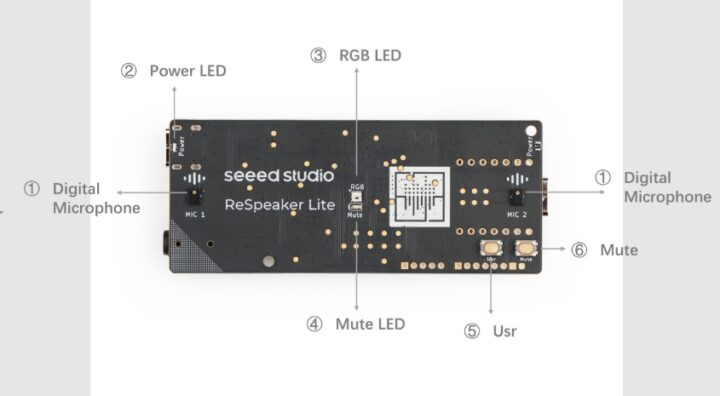
ReSpeaker Lite Voice Assistant Kit integrates with Home Assistant via ESPHome firmware, supports Amazon Alexa and Google Assistant, and is compatible with Arduino, PlatformIO, MicroPython, and CircuitPython. The kit supports custom firmware updates via DFU-Util and offers I2S and USB connections for use with MCUs, SBCs, and PCs like Raspberry Pi. You’ll find a getting-started guide and can explore various testing and applications such as I2S Test, Streams Generator, CSV Converter, MP3 Player, Keyword Spotting, and MQTT Audio Streaming on the wiki. The guides also include instructions for building a Voice Assistant for Home Assistant using custom wake words.
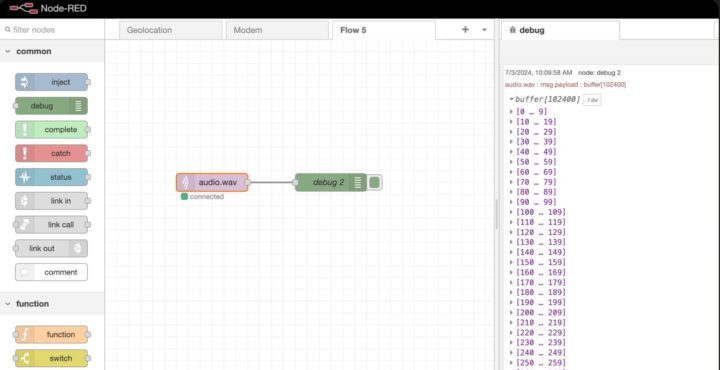
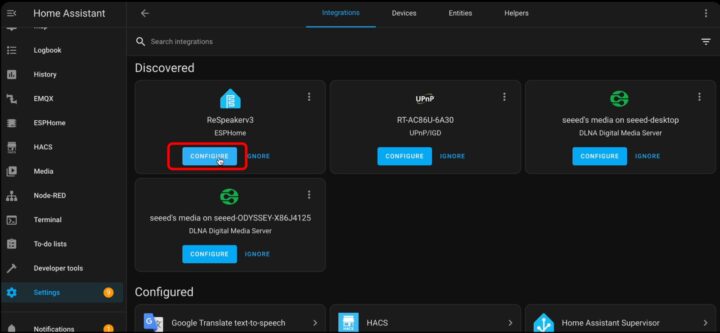 Node-RED MQTT audio streaming and Home Assistant integration
Node-RED MQTT audio streaming and Home Assistant integrationThe ReSpeaker Voice Assistant Kit with 5W speaker and black acrylic enclosure is now available for $33.91 on the Seeed Studio store, and you’ll find the ReSpeaker Lite board only for $24.90 and the ReSpeaker Voice Assistant Kit for $29.91 on the same page.

Sayantan Nandy, an electronics engineer with over four years of hands-on experience in PCB design, circuit development and power electronics, is proficient in EAGLE CAD, Ki-Cad, and Altium. He has a proven track record of delivering efficient and effective systems. His expertise extends from R&D, and prototyping to production support, making him a valuable asset to any engineering team.
Support CNX Software! Donate via cryptocurrencies, become a Patron on Patreon, or purchase goods on Amazon or Aliexpress


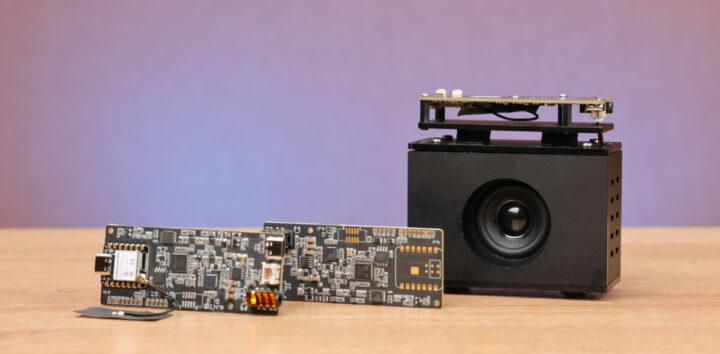
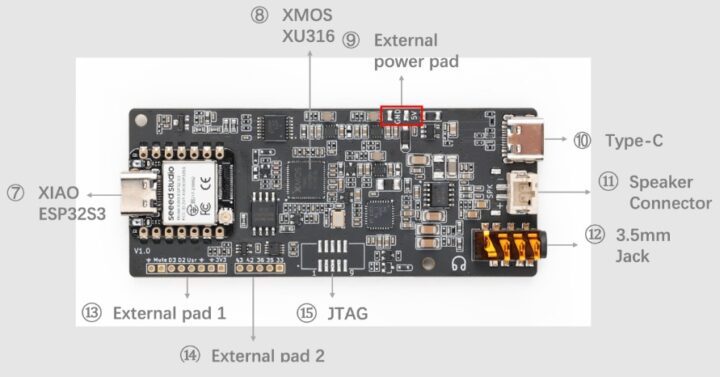



Would it be possible to add an ADC (Analog to Digital Converter) to it to get analogue audio input port from a source like a turntable (vinyl record player) to create a music streamer?
That would make an less expensive solution to a HiFiBerry ADC and Raspberry Pi based combination needed to run an Icecast and Darkice server for streaming like this https://github.com/quebulm/Raspberry-Pi-Vinyl-Streamer
WOOT! Stumbled on this new “voice-kit” GitHub repository where ESPHome developers are developing new or improved components for I2S audio (XMOS) support and media playback support for FLAC, etc. for the upcoming voice-kit hardware platform from Nabu Casa: https://github.com/esphome/voice-kit/
They already added features and functions or improvements/enhancements to ESPHome, such as:
New: Nabu Media Player – new “nabu” media player from Nabu Casa running natively on ESP32
Music Assistant streams work (both mp3 and flac), but since it requires resampling, the audio quality isn’t great
New: Added support for FLAC filesNew: Added a proper WAV decoder (that parses WAV headers with LIST, INFO, etc. chunks.)
New: Initial support for playing back local files
New: Playback Control for the VoiceKit
Added an is_paused condition for media players.
New: Add Click to Converse to button
New: LED animation
New: Scripts for controlling LEDs
New: Update Button Behaviour for the Voice kit
New: Dial Volume Control
New: Timer basic implementation
New: Dial Volume Control
New: Added HTTP(s) OTA updates
New: Dial Volume Control
New: Added Buttons for force ota update.
New: Software Mute Switch
Improvement: A basic resampler adjusts sample rates
Improvement: Configurable output sample rate (for experimental 48kHz XMOS firmware)
Improvement: The DAC mute state is read on boot
Improvement: volume/mute control via the DAC (the wheel works for increasing/decreasing volume)
Improvement: Logs what element failed if the pipeline breaks
Improvement: Fails gracefully if the incoming stream can’t be processed
Improvement: Differentiate between user facing LED Ring and Internal LED ring
Point external component to dev branch
They also have many TODO inline coments in the code there if anyone are interested in helping them:
https://github.com/search?q=repo%3Aesphome%2Fvoice-kit%20todo&type=code
Note! Be aware that there are many comments there to that most of the new stuff are not yet stable.
Wow, looks great!
I have one of the respeaker lite kits. It’s still early but at them moment the firmware from Seeed seems to do nothing, the person heading the above project already said on the HA forums this won’t work because it can’t do full-duplex mode.
Nabu/HA and Nvidia already ported all the voice stuff to GPU based. The only issue is it’s only for the Nvidia Jetson lineup so not a cheap entry fee. They have a docker package available now. They had so many issues trying to do it on 2 machines they finally just wrote HA Core fir the Jetson so everything runs on it including any LLM stuff you might be interested in.
https://github.com/dusty-nv/jetson-containers/tree/master/packages/smart-home/homeassistant-base
What is the exaxt SKU of the XMOS chip that these ReSpeaker Lite models are using?
https://www.xmos.com/processor-catalogue/
Looks like they are probably using XU316-1024-QF60A-C24 or XU316-1024-QF60A-C32 maybe? I believe the XU316-1024-QF60A-C24 is also used on XMOS’s “XK-VOICE-L71 Voice Reference Design Evaluation Kit” https://www.xmos.com/xk-voice-l71
I have once if these. Honestly it’s not that impressive at the moment and Seeed tends to release examples and move on to the next thing. There HA example is using Openwakeword for example although I updated it to support microwakeword.and.ooated the yaml.on the HA forums this morning ironically.. This thing is essentially a 2 mic respeaker with added bells and whistles mostly aimed towards developing. Like pins to the XMOS chip on program.
Anything added will be done by the community and mine shipped without the LED working, others have had issues. It is super beta at the moment and feels like a rushed product.
Nabu/HA has said their voice assistant, no date available, will have an XMOS chip. Confirmed better then this (model wise) but nobody has written firmware for XMOS chips and ESP32/Espressif’s ESP-IDF dev software.
They hinted at 2 3.5mm jacks one for input and one for output. It’s also going to be running in. ESPHome so it will just work out of the box, be supported for 2 years or more software wise and probably be the voices team main testing voice assistant so….. Honey’s right now a. Wyoming satellite is the best option until they get this firmware/software down. They will, it will just be incremental.
That is unless you go but an Nvidia Jetson as you can run HA Core now and all voice add ons and everything needed has been ported to GPU based. Only problem is it’s about 800 to 2000 (tope end and recommend model dependent on needs) so that will have to wait for hardware prices to comes down.
This is what’s on the XMOS chip
XMOS
V16A0
CT2351P2
TFTT47.00